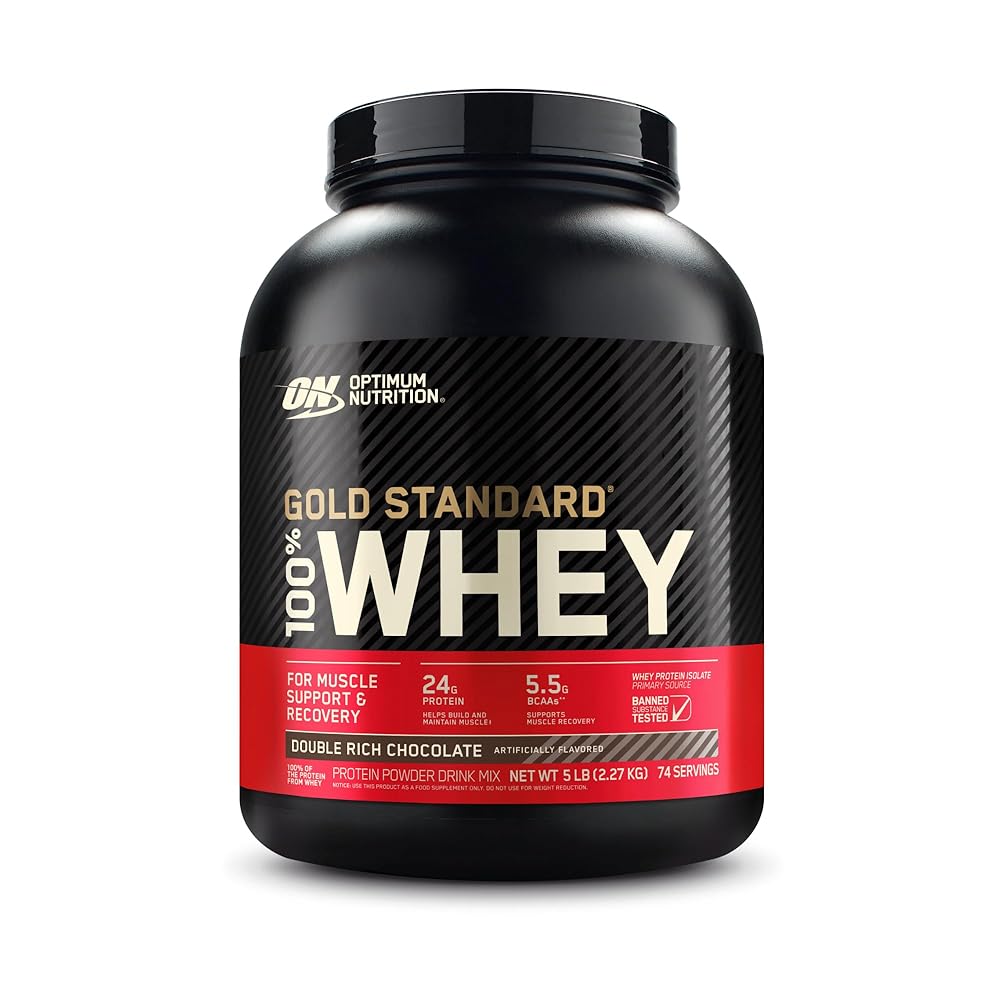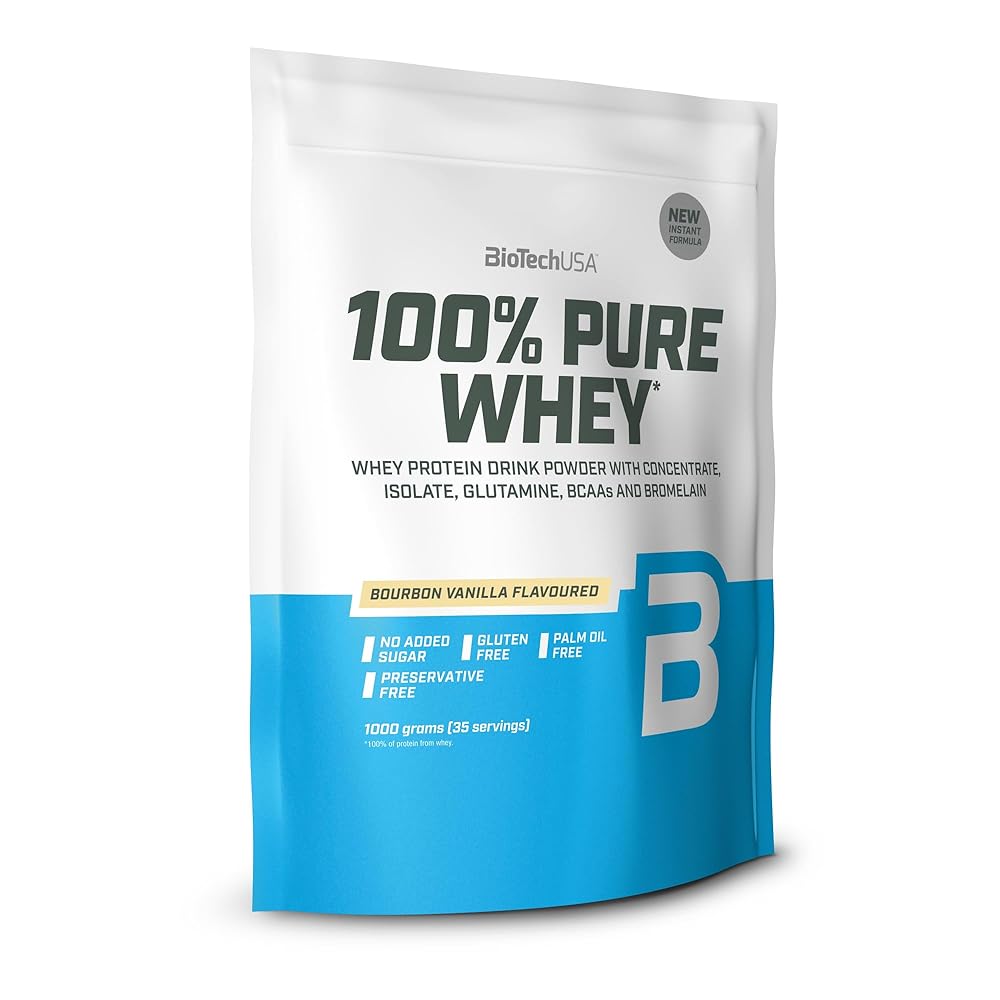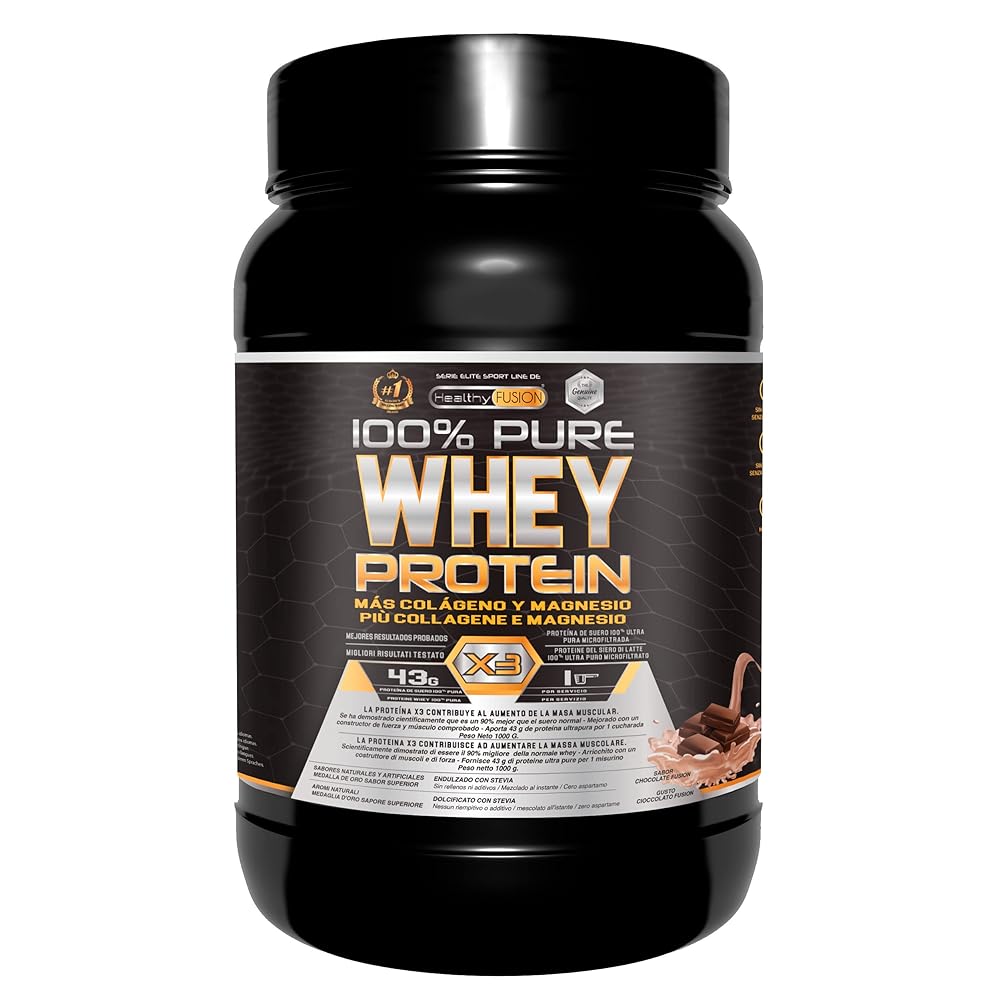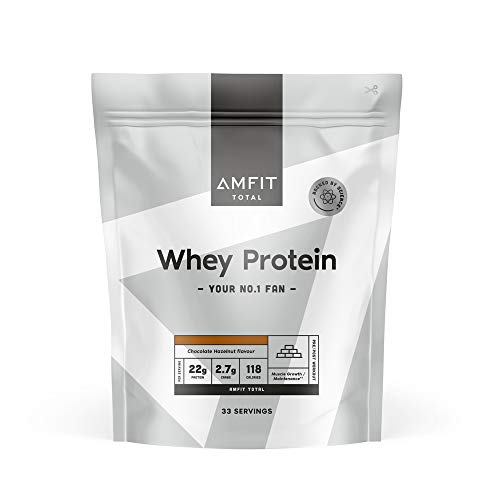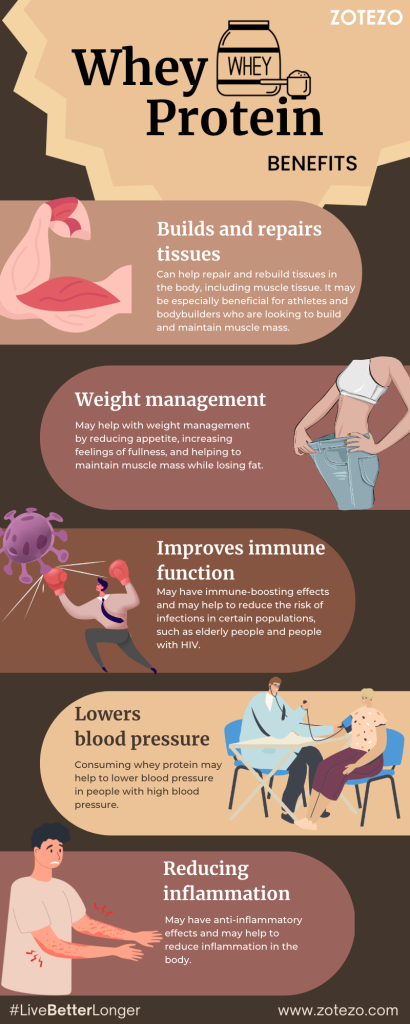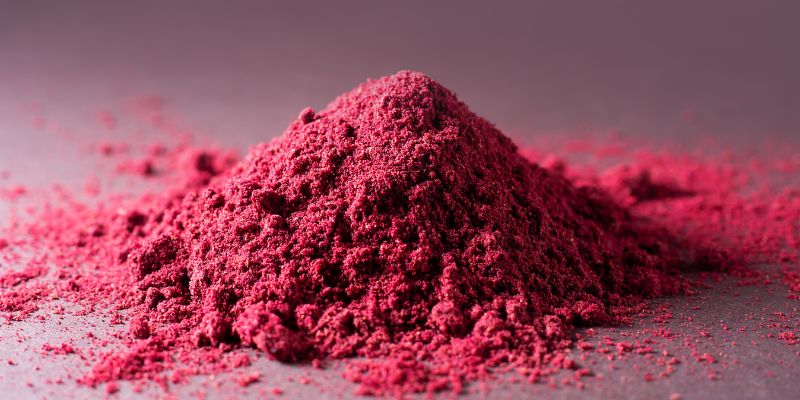Introduction
In the segment of nutrition and fitness, one ingredient has stood the test of time, consistently earning its place on the list of must-haves for health enthusiasts and athletes alike: whey protein. It’s the darling of the supplement world, renowned for its remarkable ability to support muscle growth, aid in weight management, and contribute to overall well-being.
But with countless brands and formulations flooding the market, choosing the best whey protein powder for your needs can be as daunting as navigating a complex workout routine. Fear not, for in this comprehensive guide, we’re about to embark on a journey that will demystify the world of whey protein. From understanding the different types of whey to deciphering those baffling labels, we’ve got you covered.
Whether you’re a seasoned gym-goer looking to enhance your gains or someone simply seeking to boost their daily protein intake, you’re in for a treat. We’ll explore the science behind whey protein, delve into the benefits it offers, and reveal the top contenders of whey protein in Spain. Get ready to discover the best whey protein powder that aligns perfectly with your health and fitness goals, as we empower you to make informed choices on your path to a healthier, stronger you!

Our pick of the 4 best Whey Protein Powder of 2024 in Spain
Zotezo Score | Best Whey Protein | Lowest Price |
|---|---|---|
|
A |
||
|
B |
||
|
B |
||
|
C+ |
Let's take a deep dive into these 4 best Whey Protein in Spain
Best Overall Whey Protein in Spain
Glanbia Performance Nutrition
A
Zotezo review
The Optimum Nutrition Gold Standard 100% Whey protein powder offers fast-absorbing whey protein enriched with glutamine and BCAA amino acids, perfect for supporting physical transformation. However, the disappointing chocolate flavor might not appeal to all users.
Product details
Benefits of Optimum Nutrition Gold Standard ...
Drawbacks
B
Zotezo review
The BioTechUSA 100% Pure Whey is a high-quality protein supplement with added BCAAs and a wide variety of flavors. However, some users may find the intense strawberry flavor overwhelming and the sweetness too much for their taste.
Product details
Benefits of BioTechUSA Whey Protein Powder V...
Weaknesses
Laboratorio Fersa Ibérica
B
Zotezo review
The Healthy Fusion Whey Protein is a high-quality product that offers a blend of pure whey protein, collagen, and magnesium to enhance workouts and support muscle mass. With easy dissolvability, various flavors, and positive feedback from long-time users, this protein powder is a great choice for those looking to improve their fitness regimen.
Product details
Benefits of Fusion Whey Protein with Collage...
Disadvantages
C+
Zotezo review
The Marca Amazon – Amfit Nutrition Whey Protein Powder in Chocolate with Hazelnuts is a high-quality and versatile protein supplement that offers a complete amino acid profile for muscle recovery and growth. While providing convenient mixing and a variety of enjoyable flavors, customers should be aware of potential fluctuations in flavor availability and price increases over the years.
Product details
Benefits of Amazon Brand – Amfit Whey ...
Negatives
Various Types of Whey Protein
When it comes to choosing the best whey protein powder, it’s essential to understand that not all whey proteins are created equal. The world of whey protein offers a variety of options, each with its unique characteristics and benefits. Let’s break down the various types of whey protein to help you make an informed choice that aligns with your nutritional goals.
1. Whey Protein Concentrate (WPC):
- WPC is the most common form of whey protein. It contains varying levels of protein, typically ranging from 70% to 80%, with the remainder composed of fats and carbohydrates.
- This type of whey protein retains some beneficial nutrients, such as immunoglobulins and lactoferrin, making it a good choice for overall health.
- WPC is often preferred for its creamy texture and slightly sweet taste, making it a versatile option for shakes, smoothies, and baking.
2. Whey Protein Isolate (WPI):
- WPI undergoes additional processing to remove most of the fats and lactose, resulting in a product that is 90% or more pure protein.
- It’s an excellent choice for individuals with lactose intolerance or those aiming to minimize calorie intake while maximizing protein content.
- WPI is quickly absorbed by the body, making it an ideal post-workout option to support muscle recovery.
3. Whey Protein Hydrolysate (WPH):
- WPH is pre-digested, meaning it’s broken down into smaller protein fragments, making it easier to digest and less likely to cause allergic reactions.
- It’s an ideal choice for infants, the elderly, or individuals with digestive issues, as it’s gentle on the stomach.
- Athletes may also benefit from WPH due to its rapid absorption, which helps with muscle repair and growth.
4. Native Whey Protein:
- Native whey protein is extracted directly from fresh milk, resulting in a protein with a higher leucine content, an amino acid crucial for muscle protein synthesis.
- It’s minimally processed and retains more of its natural nutrients compared to other forms of whey protein.
- If you’re looking for the purest and most unadulterated whey protein source, native whey is an excellent choice.
5. Flavored and Specialty Whey Proteins:
- Manufacturers often enhance whey protein powders with flavors like chocolate, vanilla, or fruity options, making them more enjoyable to consume.
- Specialty whey protein products may contain added ingredients such as collagen, creatine, or branched-chain amino acids (BCAAs) to cater to specific fitness or health goals.
How does whey protein work
Whey protein demonstrates a notable resistance to coagulation in the stomach, allowing it to swiftly move into the intestines, a characteristic that distinguishes it from proteins like casein. In contrast to other protein sources such as tuna, turkey, and egg, leucine levels in the blood spike approximately 40–60 minutes after the ingestion of whey protein. This rapid increase in leucine contributes to the swift stimulation of muscle protein synthesis (MPS), setting whey apart as an efficient promoter of this crucial process.
Unveiling the Best: How We Tested Whey Protein Supplements
In the ever-expanding universe of whey protein supplements, our quest to unearth the best of the best was a meticulous journey anchored in scientific rigor and a commitment to providing you with trustworthy insights. As dietitian authors, our mission was clear: to navigate the sea of protein powders and bring you recommendations backed by thorough testing and a deep understanding of nutritional needs.
1. Researching the Landscape: Beyond the Hype
Our journey began by immersing ourselves in the vast landscape of whey protein supplements. We scrutinized market trends, consumer reviews, and expert opinions to create a comprehensive list of contenders. This initial step allowed us to grasp the diverse array of products available, ensuring our testing would encompass various formulations, flavors, and brands.
2. Defining Evaluation Criteria: What Matters Most
Understanding the nuances of what makes a whey protein supplement exceptional guided our formulation of evaluation criteria. Protein content, amino acid profile, ingredient quality, flavor, mixability, and the absence of undesirable additives were among the key factors we prioritized. These criteria were designed to address the multifaceted needs of individuals seeking protein supplementation for various purposes, whether it be muscle building, weight management, or overall nutritional support.
3. Lab Testing: The Scientific Backbone
To establish a solid foundation for our assessments, we conducted rigorous lab testing on each whey protein supplement in our lineup. This involved not only verifying the accuracy of claimed protein content but also delving into the amino acid composition. Amino acids are the building blocks of proteins, and their profile is crucial for assessing the protein’s quality and its ability to support diverse health and fitness goals.
4. Sensory Analysis: Beyond the Numbers
While lab tests provided a quantitative backbone, we knew that the subjective experience of consuming a whey protein supplement matters just as much. Sensory analysis played a pivotal role in our evaluation, encompassing aspects such as flavor, texture, and mixability. After all, a protein powder that doesn’t just meet nutritional needs but also delights the taste buds is more likely to become a consistent and enjoyable part of your routine.
5. Real-world Application: Field Testing
Our commitment to authenticity led us to the next phase of our testing – real-world application. We enlisted the help of diverse individuals, from fitness enthusiasts to those seeking convenient nutritional solutions. Their feedback, combined with our own experiences, allowed us to evaluate how each whey protein supplement integrated into daily life, addressing factors like solubility in different liquids, versatility in recipes, and overall satisfaction with the product.
6. Considering Dietary Preferences: Catering to All
We understand that dietary preferences vary widely, and our testing process reflected this diversity. We evaluated whey protein supplements catering to specific needs, including those with lactose intolerance or preferences for plant-based alternatives. Our goal was to provide recommendations that accommodate a spectrum of dietary choices without compromising on nutritional quality.
7. Transparency in Labeling: A Non-negotiable
Transparent labeling is paramount in ensuring consumers know exactly what they’re putting into their bodies. We scrutinized each product’s ingredient list, seeking clarity on protein sources, the presence of artificial additives, and potential allergens. Products that met our stringent standards for transparency earned higher marks in our evaluations.
8. Long-term Considerations: Sustainability and Ethics
As dietitian authors, we recognize the importance of long-term considerations beyond immediate nutritional needs. We explored the sustainability practices and ethical considerations of the brands behind the whey protein supplements. This holistic approach aimed to align our recommendations with values that extend beyond personal health to the health of the planet and ethical business practices.
9. Continuous Monitoring: Staying Current
The world of nutrition is dynamic, with formulations and consumer preferences evolving over time. Our commitment to providing up-to-date and relevant information led us to establish a system for continuous monitoring. We stay abreast of new product releases, industry developments, and emerging scientific research to ensure that our recommendations reflect the latest and best in the world of whey protein supplements.
Various types and needs for Whey Protein
Whey Protein come in various types, each catering to different target audiences based on their specific needs and preferences. In this article, we have done extensive research, and reviewed the below mentioned types of Whey Protein Powder :
By Types of Whey Protein
- Concentrate Whey Protein
- Isolate Whey Protein
- Hydrolysate Whey Protein
- Native Whey Protein
- Grass-fed Whey Protein
By Audience & Needs
- Whey Protein For Men
- Whey Protein For Women
- Whey Protein For Athletes
- Whey Protein For Bodybuilders
- Whey Protein For Weight Loss
Our effort is aimed to provide a diverse range of Whey Protein Powder to ensure that individuals from various backgrounds and wellness goals can find a suitable option to optimize their wellbeing and achieve their desired outcomes.
Tips for choosing the right Whey Protein Powder for you
Selecting the right whey protein powder can be a daunting task with the myriad of options available on the market. To make an informed choice that aligns with your health and fitness goals, it’s essential to consider several factors. In this comprehensive buyer’s guide, we’ll walk you through the key aspects to keep in mind when shopping for the best whey protein in Spain, including FDA guidelines, certifications, and necessary details.
1. Protein Type:
As we discussed earlier, there are various types of whey protein, including Whey Protein Concentrate (WPC), Whey Protein Isolate (WPI), Whey Protein Hydrolysate (WPH), and Native Whey Protein. Determine which type suits your goals and dietary requirements. If you’re lactose intolerant or have allergies, opt for WPI or WPH. For muscle growth and general health, WPC and native whey can be suitable.
2. Protein Content:
Check the protein content per serving. Ideally, a quality whey protein powder should contain at least 20 grams of protein per serving. Some premium products can provide up to 30 grams or more per serving, offering a potent protein punch.
3. Ingredient List:
Examine the ingredient list for additives, fillers, and artificial ingredients. The shorter the ingredient list, the better. Look for products with minimal additives and no artificial flavors, colors, or sweeteners.
4. Sugar and Carbohydrate Content:
Keep an eye on the sugar and carbohydrate content. Many flavored whey protein powders may contain added sugars. If you’re watching your carbohydrate intake or prefer a low-sugar option, choose a product with little to no added sugars.
5. Fat Content:
Whey protein concentrate (WPC) naturally contains some fat, while whey protein isolate (WPI) and whey protein hydrolysate (WPH) are virtually fat-free. Depending on your dietary preferences, consider the fat content when selecting a product.
6. Lactose Content:
If you’re lactose intolerant, opt for products labeled as lactose-free or choose whey protein isolate (WPI) or whey protein hydrolysate (WPH), as these options contain minimal lactose.
7. Serving Size:
Pay attention to the recommended serving size, as this will impact the number of servings per container. It’s essential to follow the suggested serving size to achieve your desired protein intake.
8. Certifications and Quality Assurance:
Look for certifications and quality assurance. Reputable brands often carry certifications such as USDA Organic, Non-GMO Project Verified, or Informed-Choice. These certifications ensure that the product meets specific standards for quality and safety.
– Informed-Choice is especially important for athletes, as it certifies that the product is free of banned substances, ensuring you can use it without concerns for doping violations.
9. Third-Party Testing:
Some manufacturers conduct third-party testing for purity and potency. This extra layer of quality control can provide peace of mind regarding the product’s authenticity and safety.
10. Flavour and Texture:
Consider the flavour and texture of the whey protein powder. Whey protein is available in a wide range of flavors, from classic vanilla and chocolate to more unique options like salted caramel or cookies and cream. Read reviews and consider personal taste preferences.
11. Price per Serving:
Although money is subjective, varies person to person but do evaluate the cost per serving to ensure you’re getting good value for your money. While premium products may be more expensive, they often provide higher protein content and superior quality.
12. Allergen Information:
Check for allergen information, especially if you have allergies. Whey protein products may be processed in facilities that handle common allergens like soy, nuts, or gluten. Look for products with clear allergen statements.
13. Recommended Dosage:
Consult with a healthcare professional or registered dietitian to determine your specific protein needs. They can help you calculate your daily protein requirements based on your age, gender, activity level, and goals.
14. FDA Guidelines:
Keep in mind that the Food and Drug Administration (FDA) regulates dietary supplements, including whey protein powders. While the FDA does not pre-approve supplements for safety and effectiveness, they do monitor product safety and have established Good Manufacturing Practices (GMPs) that manufacturers should follow. Look for products that adhere to these guidelines.
15. Mixability:
Some whey protein powders may clump or not mix well with liquids. Consider the mixability of the product to ensure it blends smoothly into your preferred beverages or recipes.
16. Shelf Life and Storage:
Check the expiration date and storage recommendations to ensure the product remains fresh and effective throughout its shelf life.
By taking these crucial factors into account, you can make an informed decision when choosing the best whey protein for your needs. Remember that the best whey protein is the one that aligns with your individual goals, dietary preferences, and lifestyle, while also meeting the highest standards of quality and safety.
Products listed here are carefully reviewed and tested by our expert authors and reviewers. If you buy through links on this page, we may earn a small commission. Here’s our editorial process.
How we reviewed these products
Benefits of using Whey Protein Powder
Whey protein, often hailed as the gold standard in protein supplementation, has garnered a well-deserved reputation for its multitude of health benefits. Derived from milk during cheese production, whey protein has become a staple in the diets of athletes, fitness enthusiasts, and health-conscious individuals. In this comprehensive guide, we’ll explore the extensive array of benefits that come with incorporating whey protein into your daily nutrition regimen, taking into account the various types of whey protein and their specific advantages.
1. High-Quality Protein Source:
Whey Protein Concentrate (WPC), Whey Protein Isolate (WPI), and Native Whey Protein: These forms of whey protein offer a complete source of high-quality protein, containing all essential amino acids required for muscle growth, repair, and overall health.
Whey Protein Hydrolysate (WPH): With its predigested nature, WPH is particularly gentle on the digestive system, making it an excellent option for those with sensitive stomachs.
2. Muscle Growth and Repair:
All Types of Whey Protein: The rich amino acid profile in whey protein, especially branched-chain amino acids (BCAAs) like leucine, helps stimulate muscle protein synthesis. This is crucial for muscle growth and post-exercise recovery, making whey protein a go-to choice for athletes and fitness enthusiasts.
3. Weight Management:
WPI and WPH: These forms of whey protein are virtually lactose and fat-free, making them ideal for individuals looking to increase their protein intake while managing calorie and fat consumption. The high protein content also promotes a feeling of fullness, reducing overall food consumption.
4. Enhanced Immunity:
WPC: Whey protein concentrate contains immunoglobulins and lactoferrin, which have immune-boosting properties. Regular consumption can help support your body’s defense mechanisms.
5. Improved Antioxidant Defense:
Native Whey Protein: It contains higher levels of cysteine, a precursor to the antioxidant glutathione, which plays a crucial role in protecting cells from oxidative damage.
6. Management of Blood Sugar Levels:
WPI: Some research suggests that consuming whey protein isolate before or alongside carbohydrate-rich meals may help regulate blood sugar levels, making it beneficial for individuals with diabetes or those concerned about blood sugar spikes.
7. Blood Pressure Regulation:
WPC: Studies have shown that whey protein may have a modest blood pressure-lowering effect, potentially reducing the risk of hypertension.
8. Heart Health:
WPC and WPI: Whey protein can contribute to heart health by helping to reduce LDL cholesterol levels and improve the overall lipid profile in the blood.
9. Post-Exercise Recovery:
All Types of Whey Protein: Whey protein is rapidly absorbed by the body, making it an ideal post-workout choice to replenish depleted protein stores, reduce muscle soreness, and promote faster recovery.
10. Appetite Control and Weight Loss:
WPI and WPH: High-protein diets, including those enriched with whey protein, have been linked to reduced appetite, increased feelings of fullness, and improved weight management.
11. Management of Inflammatory Conditions:
Native Whey Protein: Its anti-inflammatory properties can potentially assist in managing chronic inflammatory conditions.
12. Support for Special Diets:
WPH: Its hypoallergenic nature and easy digestibility make it a suitable option for infants and individuals with food allergies or intolerances.
13. Cognitive Function:
Whey Protein: Some research suggests that whey protein may have a positive impact on cognitive function, including memory and mood regulation.
14. Preservation of Lean Muscle Mass During Weight Loss:
All Types of Whey Protein: When combined with a reduced-calorie diet, whey protein can help preserve lean muscle mass, preventing muscle loss during weight loss efforts.
15. Enhanced Nutrient Delivery:
All Types of Whey Protein: Whey protein has been shown to increase the absorption of certain nutrients, including minerals like calcium and magnesium, supporting overall bone health.
16. Improves Gut Health:
WPC and WPI: These forms of whey protein contain bioactive compounds that may support a healthy gut microbiome, promoting digestive well-being.
17. Versatility and Convenience:
All Types of Whey Protein: Whey protein powders can be easily incorporated into a wide range of recipes, from shakes and smoothies to baked goods, providing a convenient way to boost your daily protein intake.
18. Enhanced Exercise Performance:
All Types of Whey Protein: Regular consumption of whey protein can improve endurance, strength, and overall exercise performance, making it a favorite among athletes.
It’s essential to note that while whey protein offers a wide range of benefits, its effectiveness may vary from person to person. Factors such as individual dietary needs, lifestyle, and fitness goals can influence the extent to which these benefits are realized. Additionally, the type of whey protein chosen should align with your specific requirements, whether it’s muscle gain, weight loss, improved digestion, or overall health maintenance.
Incorporating whey protein into your daily routine can be a game-changer for your health, fitness and overall wellness journey. However, it’s crucial to consult with a healthcare professional or registered dietitian before making significant changes to your diet, especially if you have underlying health conditions or concerns. They can provide personalized guidance to help you maximize the benefits of whey protein while ensuring it complements your overall nutrition plan.
Side-effects of using Whey Protein
While whey protein offers a multitude of benefits, it’s essential to be aware that, like any dietary supplement, it may have potential side-effects for some individuals. It’s crucial to understand these potential drawbacks to make informed choices about incorporating whey protein into your diet. In this comprehensive guide, we’ll delve into some of the possible side-effects associated with whey protein consumption and how to mitigate them.
1. Digestive Issues:
Gastrointestinal Distress:-
Some individuals may experience bloating, gas, cramps, or diarrhea when first introducing whey protein into their diets. This is often due to lactose intolerance, as whey protein concentrate (WPC) contains small amounts of lactose.
Sensitivity to Dairy Proteins:-
People with dairy allergies or sensitivities may also experience digestive discomfort when consuming whey protein. In such cases, choosing lactose-free or dairy-free whey protein options like whey protein isolate (WPI) or whey protein hydrolysate (WPH) can help alleviate these symptoms.
2. Kidney Strain:
Increased Protein Intake:-
Whey protein is a high-quality source of protein, but excessive consumption, especially in those with pre-existing kidney issues, may strain the kidneys. This is due to the increased workload of processing the additional nitrogen from protein breakdown.
Hydration:-
To mitigate potential kidney strain, it’s essential to stay well-hydrated when consuming whey protein. Adequate fluid intake helps the kidneys flush out waste products.
3. Allergic Reactions:
Allergies to Milk Proteins:-
Whey is a milk-derived protein, and individuals with milk allergies may experience allergic reactions when consuming whey protein. Symptoms can range from mild hives to severe anaphylaxis.
Cross-Contamination:-
Whey protein products may also be processed in facilities that handle allergens like soy, peanuts, or tree nuts, leading to potential cross-contamination. Always check labels for allergen warnings and choose certified allergen-free options if necessary.
4. Weight Gain:
Caloric Intake:-
While whey protein can support weight management when consumed mindfully, excessive intake without adjusting overall caloric intake can lead to weight gain. It’s essential to incorporate whey protein into your diet while considering your overall energy balance and nutritional goals.
5. Unpleasant Taste and Texture:
Personal Preference:-
Some individuals may find the taste or texture of whey protein powders unappealing, leading to difficulties in incorporating them into their diet. Exploring different flavors and brands can help find one that suits your palate.
6. Nutrient Imbalances:
Relying Solely on Supplements:-
Depending solely on whey protein supplements for your protein intake can lead to nutrient imbalances, as whole foods offer a more comprehensive array of essential nutrients.
Consultation with a Dietitian:-
If you plan to make whey protein a significant part of your diet, consider consulting with a registered dietitian to ensure your overall nutrient needs are met.
7. Potential for Overconsumption:
Following Label Recommendations:-
It’s crucial to follow the serving size recommendations provided on the whey protein product label. Overconsumption can lead to unnecessary caloric intake and an excess of certain nutrients.
8. Interactions with Medications:
Blood Pressure Medications:-
Some whey protein supplements contain peptides called ACE inhibitors, which may interact with certain blood pressure medications. Consult with your healthcare provider if you’re taking medications regularly.
9. Risk of Contaminants:
Contaminated Products:-
While reputable manufacturers adhere to strict quality standards, there have been cases of contamination in dietary supplements. To minimize this risk, choose products from established and trusted brands, and consider third-party testing certifications.
10. Difficulty in Gauging Protein Needs:
Individual Variation:-
Determining your ideal protein intake can be challenging, as individual needs vary based on factors like age, activity level, and overall health. This can lead to overconsumption or inadequate protein intake if not properly assessed.
Who should use Whey Protein Powder
There’s a multitude of options to cater to the unique needs and preferences of various individuals. To help you make an informed choice, it’s crucial to understand how different types of whey protein align with specific goals and dietary requirements. Let’s explore the target audience for whey protein and the types that best suit their needs.
1. Fitness Enthusiasts and Athletes:
Target Audience: Active individuals, bodybuilders, and athletes seeking to optimize muscle growth, recovery, and performance.
Whey Protein Types: Whey Protein Isolate (WPI) and Whey Protein Hydrolysate (WPH) are ideal for this group. WPI offers high protein content with minimal carbs and fats, while WPH is predigested for quick absorption, aiding post-workout recovery.
2. Weight Management Seekers:
Target Audience: Individuals aiming to lose or maintain weight while ensuring adequate protein intake.
Whey Protein Types: Whey Protein Isolate (WPI) and Whey Protein Hydrolysate (WPH) are excellent choices here as well. These options are low in calories and carbohydrates, helping with satiety and muscle preservation during weight loss.
3. Individuals with Lactose Intolerance:
Target Audience: People who are lactose intolerant or have difficulty digesting lactose.
Whey Protein Types: Whey Protein Isolate (WPI) and Whey Protein Hydrolysate (WPH) are low in lactose and often well-tolerated by those with lactose intolerance.
4. Health-Conscious Consumers:
Target Audience: Individuals looking to support their overall health and well-being.
Whey Protein Types: Whey Protein Concentrate (WPC) and Native Whey Protein offer a balance between protein content and retaining beneficial nutrients, making them suitable for those focused on holistic health.
5. Vegetarians and Vegans:
Target Audience: Plant-based eaters seeking a high-quality protein source.
Whey Protein Types: While whey protein is derived from milk, some manufacturers offer plant-based protein blends that incorporate ingredients like pea protein, rice protein, or hemp protein to cater to vegetarian and vegan preferences.
Seniors and Aging Individuals:
Target Audience: Older adults looking to maintain muscle mass, bone health, and overall vitality.
Whey Protein Types: Whey Protein Concentrate (WPC) and Native Whey Protein provide essential nutrients and amino acids that can support aging-related health concerns.
7. Individuals with Dietary Restrictions or Allergies:
Target Audience: Those with allergies or dietary restrictions, such as soy, gluten, or dairy allergies.
Whey Protein Types: Look for specialized whey protein products that are certified allergen-free, dairy-free, or gluten-free to accommodate specific dietary needs.
8. Those Managing Chronic Health Conditions:
Target Audience: People with specific health conditions, such as diabetes, hypertension, or inflammatory disorders.
Whey Protein Types: Whey Protein Isolate (WPI) and Native Whey Protein can be suitable due to their low carbohydrate content and potential benefits in managing blood sugar levels, blood pressure, and inflammation.
9. Parents and Infants:
Target Audience: Parents seeking safe and nutritious options for infant formula and baby food.
Whey Protein Types: Whey Protein Hydrolysate (WPH) is often used in specialized infant formulas and baby food due to its hypoallergenic nature and easy digestibility.
10. General Health and Fitness Enthusiasts:
Target Audience: Individuals looking to enhance their overall health and fitness, whether for general well-being or casual exercise.
Whey Protein Types: Whey Protein Concentrate (WPC) and Native Whey Protein offer a balanced approach, providing essential nutrients while supporting muscle health and recovery.
Recommended Dosage of Whey Protein
The recommended usage of whey protein will vary depending on an individual’s dietary needs and goals. Generally, the recommended daily protein intake is 0.8 grams per kilogram of body weight for adults. However, athletes and people seeking muscle mass may require more protein.
For muscle gain and recovery, consuming 20-25 grams of whey protein is recommended within 30 minutes after exercise. Research suggests that consuming 20-40 grams of whey protein per meal effectively builds muscle.
It’s important to note that consuming too much protein can harm the kidneys, especially for people with pre-existing kidney conditions or taking certain medications. It’s always a good idea to consult a registered dietitian or a doctor before starting any supplement regimen. They can provide personalized advice based on your individual needs and health status.
It’s also important to remember that whey protein is a supplement and should not replace a healthy diet. A balanced diet that includes a variety of foods from all food groups is essential for overall health and well-being.
Understand the who, what & why behind your favourite products
Brand Values | Product Philosophy | Product USPs
Read brand stories, their raison-d'etre, and understand what drives them to caringly create the highest quality products for your well-being.
Brand stories
Frequently asked questions on Whey Protein Powder
1. Is whey isolate better?
2. Can I use a whey protein without exercise?
3. Can I drink whey protein every day?
4. Is it ok to drink protein shakes on an empty stomach?
5. Will whey protein make me fat?
6. Are protein shakes good for breakfast?
7. Does whey cause hair loss?
8. Is whey protein a steroid?
9. Is there any specific storage technique for whey protein?
10. Is whey protein bad for the liver?
Expert reviews you can rely upon
Expert Insights | Product Reviews | Connect with Experts
Gain valuable insights and read unbiased product reviews by subject matter Experts on Zotezo, the ultimate trust commerce platform, that empowers millions globally to make informed decisions for their wellbeing.
Expert Advisory
Conclusion
In our journey through the world of whey protein, we’ve explored its diverse types, unraveled its multitude of benefits, discussed potential side-effects, and provided guidance on selecting and consuming this nutritional powerhouse. Now, it’s time to reflect on the bigger picture and understand how whey protein can play a pivotal role in your pursuit of a healthier lifestyle.
Whey protein is not merely a supplement; it’s a versatile ally on your path to better health and fitness. Whether your goal is to build lean muscle, support weight management, or simply elevate your overall well-being, the right whey protein product can be a valuable addition to your daily nutrition regimen. By choosing the type of whey protein that aligns with your specific needs and preferences, you can harness its power to achieve your goals effectively.
Remember that while whey protein offers a wealth of advantages, it’s not a magic bullet. It should be part of a balanced diet that includes a variety of nutrient-rich foods. Consultation with a registered dietitian or healthcare professional can help you fine-tune your dietary plan to optimize your protein intake and overall nutrition.
As you embark on your whey protein journey, we encourage you to explore, experiment, and adapt. Try different types, flavors, and recipes to discover what suits your taste buds and lifestyle best. Your health and fitness goals are unique, and your approach to achieving them should reflect that uniqueness.
We hope this comprehensive guide to best whey protein in Spain has equipped you with the knowledge and confidence to make informed choices regarding whey protein. Your feedback is invaluable to us, as it helps us continue to provide you with the most relevant and helpful information. Please share your thoughts, questions, or suggestions with us, and let us know how we can further assist you on your quest for better health through whey protein. Together, we can unlock the full potential of this remarkable dietary supplement for a healthier, stronger you!

